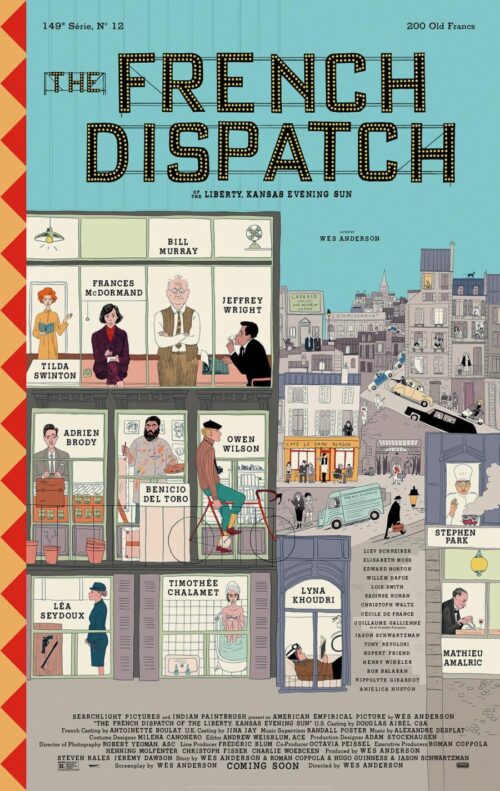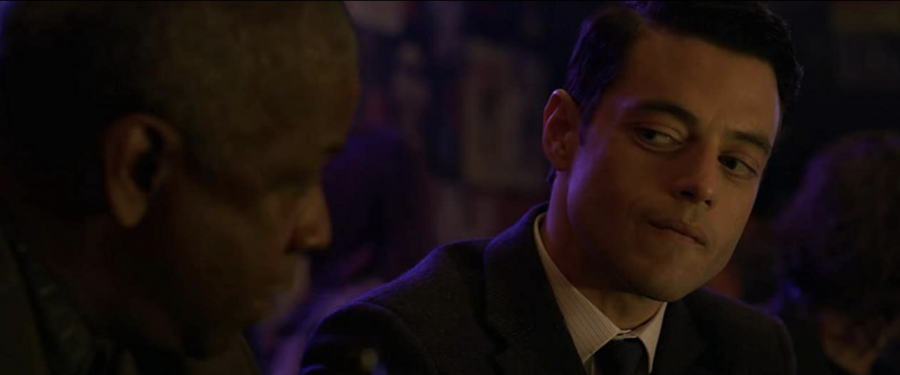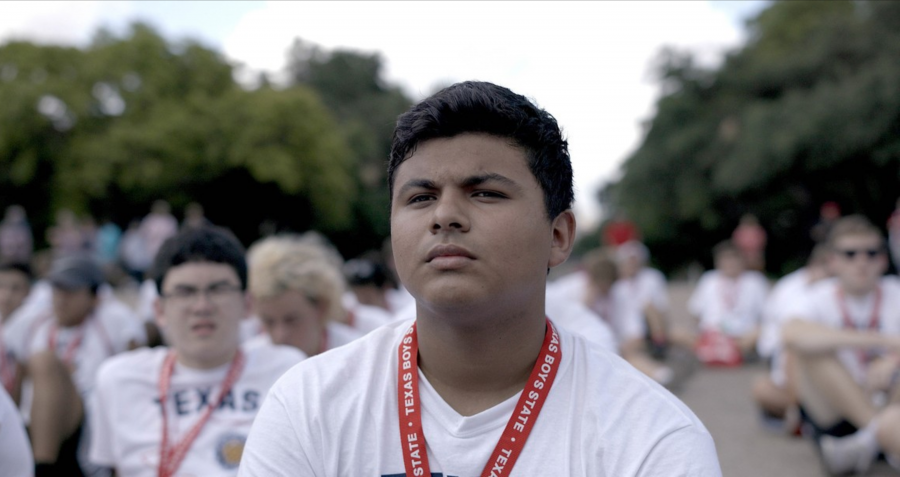Shortly after
Q: Moderator (to Zhang): “The first question I wanted to ask you was about the style of the film—the narrow aspect ratio and the bright colors. What brought you to this particular style?”
Yu (translating for Zhang): “In regards to the styling and structure of the film, [the film’s aspect ratio] is a square to kind of represent the paintings that come out of this rural Dali area. Along with the colors, Zhang really wanted to capture the vibrant red dirt, the beautiful colors on the pink traditional wear. A lot of the structure of the film is developed from the [featured] natural paintings and art.”
Q: Moderator: “We see the color pink, and [the characters] mention when they’re boxing the candy [in the film], that [the] bright-colored pink is particular to the ethnic Bai—[is this] what you mean?”
Yu (translating for Zhang): “In regards to the use of pink, the older generations—so the old grandmothers—they usually wear blue as you can see in the film, whereas those in the 40-year-old age range, they wear red. And then the younger [women], they wear pink, and so that is really where the pink comes through and you can even see it in their shoes and for the color of mud [in their paintings] is usually red or pink.”
Q: Moderator: “Thank you so much. And another question about the region is: you emphasized the food, the cooking… is the food of this region especially delicious?”
Yu (translating for Zhang): “Eating is a large part of the Bai-ethnic minority, and it’s a lot of the ways that they build community. And so we see in the weddings, in funerals, naming the child, building a house and celebrating New Year’s [that the film’s characters] all really enjoy coming together to share a large common meal. That is something Zhang Yang really realized in this community and wanted to convey through continuously filming them all having common meals, large meals, together.”
Q: Moderator: “I have another question that’s a bit complicated. [‘Up the Mountain’ is] a very beautiful film. I’m curious—maybe you don’t like giving away your magic tricks—but where did you find the balance of documenting this community and maybe staging certain shots?”
Yu (translating for Zhang): “So Zhang Yang actually lives in [Shuanglang], so being able to be around this community often, he was able to understand more of the intricacies within the culture [which] also gives him a lot more understanding. In addition to that, because he lives there, he has a lot more familiarity with the community, so [the community is] a lot more open and willing to share. In regards to striking the balance between documenting versus having [scenes] be staged, Zhang Yang knows the process and the communities that [the villagers are] a part of. So, he was able to capture the natural moments and chase after them. But also, it was having to understand how to convey the process in which [scenes] happens and that was really where it was hard to find [out] “oh, do we need to reenact this?” or “how do we piece this together?
So Zhang Yang mentioned that he really appreciated the name of this film festival as “True/False” because he says in the art of documentary you are trying the capture what is true but sometimes you will need to also restage or act out to be able to make something else true. In his last two films, he has also been trying to discover the balance between “true” and “false” in restaging and finding the most “natural way” to act naturally—how to convey what’s natural in front of a camera lens.”
Q: Audience member: “In the spirit of True/False, I found that first: the distance of the camera from the subject seemed odd to me, but then I thought it really is becoming more intimate because the camera isn’t focused on them. I also found that the lighting and the use of natural lighting, while it sometimes seemed dark, you can really see things more clearly because of the presence of the darkness. I guess it seemed counter intuitive—did it seem intuitive to [you]?”
Yu (translating for Zhang): “So first, it has to do with how the film was framed in a square. So when filming with the square you have to pull back a little bit to be able to capture as many details as you would with a rectangular frame. Second, you want to be able to pull back the frame to also capture more of the content within. To pull back, you also do not have to hassle or focus on the details because some of them can be too strong or vibrant and kind of “in your face.” By pulling [the frame] back you are able to understand the fuller—I guess “calmer”—sense.”
Q: Audience member: “Thank you for your beautiful film—the paintings were stunning. I’m curious about the commercial value of the artwork—by both [Teacher Shen and the Grannies].”
Yu (translating for Zhang): “So to begin, being able to paint together [with Teacher Shen] comes at no cost to the grandmothers. Teacher Shen really enjoys teaching and so he has an interest in [his students] so he doesn’t carry a charge to all the grandmothers. Now, the grandmothers can choose—and all the participants can choose—to sell their paintings in a gallery and each painting usually sells for 1,000 RMB, which translates to about over $1,000. For the older grandmothers, they typically choose to draw two to four [works of art] every year and they’re able to gather some money from that. As for the younger folks, sometimes they can paint up to ten [paintings]. So for these paintings, [Shen’s students] have the rights and choice to sell them to gain income.”
[vc_text_separator title=”Zhang Yang, director of ‘Up the Mountain'” color=”custom” border_width=”3″ accent_color=”#2bb673″]
‘Up the Mountain’ aired on March 2, a Q&A session followed during which the film’s director, Zhang Yang, answered questions concerning the documentary. A T/F moderator and various audience members posed the session’s questions. Alice Yu, a T/F volunteer, translated the moderator and the audience’s questions to Zhang in Chinese and his responses in return in English.Q: Moderator (to Zhang): “The first question I wanted to ask you was about the style of the film—the narrow aspect ratio and the bright colors. What brought you to this particular style?”
Yu (translating for Zhang): “In regards to the styling and structure of the film, [the film’s aspect ratio] is a square to kind of represent the paintings that come out of this rural Dali area. Along with the colors, Zhang really wanted to capture the vibrant red dirt, the beautiful colors on the pink traditional wear. A lot of the structure of the film is developed from the [featured] natural paintings and art.”
Q: Moderator: “We see the color pink, and [the characters] mention when they’re boxing the candy [in the film], that [the] bright-colored pink is particular to the ethnic Bai—[is this] what you mean?”
Yu (translating for Zhang): “In regards to the use of pink, the older generations—so the old grandmothers—they usually wear blue as you can see in the film, whereas those in the 40-year-old age range, they wear red. And then the younger [women], they wear pink, and so that is really where the pink comes through and you can even see it in their shoes and for the color of mud [in their paintings] is usually red or pink.”
Q: Moderator: “Thank you so much. And another question about the region is: you emphasized the food, the cooking… is the food of this region especially delicious?”
Yu (translating for Zhang): “Eating is a large part of the Bai-ethnic minority, and it’s a lot of the ways that they build community. And so we see in the weddings, in funerals, naming the child, building a house and celebrating New Year’s [that the film’s characters] all really enjoy coming together to share a large common meal. That is something Zhang Yang really realized in this community and wanted to convey through continuously filming them all having common meals, large meals, together.”
Q: Moderator: “I have another question that’s a bit complicated. [‘Up the Mountain’ is] a very beautiful film. I’m curious—maybe you don’t like giving away your magic tricks—but where did you find the balance of documenting this community and maybe staging certain shots?”
Yu (translating for Zhang): “So Zhang Yang actually lives in [Shuanglang], so being able to be around this community often, he was able to understand more of the intricacies within the culture [which] also gives him a lot more understanding. In addition to that, because he lives there, he has a lot more familiarity with the community, so [the community is] a lot more open and willing to share. In regards to striking the balance between documenting versus having [scenes] be staged, Zhang Yang knows the process and the communities that [the villagers are] a part of. So, he was able to capture the natural moments and chase after them. But also, it was having to understand how to convey the process in which [scenes] happens and that was really where it was hard to find [out] “oh, do we need to reenact this?” or “how do we piece this together?
So Zhang Yang mentioned that he really appreciated the name of this film festival as “True/False” because he says in the art of documentary you are trying the capture what is true but sometimes you will need to also restage or act out to be able to make something else true. In his last two films, he has also been trying to discover the balance between “true” and “false” in restaging and finding the most “natural way” to act naturally—how to convey what’s natural in front of a camera lens.”
Q: Audience member: “In the spirit of True/False, I found that first: the distance of the camera from the subject seemed odd to me, but then I thought it really is becoming more intimate because the camera isn’t focused on them. I also found that the lighting and the use of natural lighting, while it sometimes seemed dark, you can really see things more clearly because of the presence of the darkness. I guess it seemed counter intuitive—did it seem intuitive to [you]?”
Yu (translating for Zhang): “So first, it has to do with how the film was framed in a square. So when filming with the square you have to pull back a little bit to be able to capture as many details as you would with a rectangular frame. Second, you want to be able to pull back the frame to also capture more of the content within. To pull back, you also do not have to hassle or focus on the details because some of them can be too strong or vibrant and kind of “in your face.” By pulling [the frame] back you are able to understand the fuller—I guess “calmer”—sense.”
Q: Audience member: “Thank you for your beautiful film—the paintings were stunning. I’m curious about the commercial value of the artwork—by both [Teacher Shen and the Grannies].”
Yu (translating for Zhang): “So to begin, being able to paint together [with Teacher Shen] comes at no cost to the grandmothers. Teacher Shen really enjoys teaching and so he has an interest in [his students] so he doesn’t carry a charge to all the grandmothers. Now, the grandmothers can choose—and all the participants can choose—to sell their paintings in a gallery and each painting usually sells for 1,000 RMB, which translates to about over $1,000. For the older grandmothers, they typically choose to draw two to four [works of art] every year and they’re able to gather some money from that. As for the younger folks, sometimes they can paint up to ten [paintings]. So for these paintings, [Shen’s students] have the rights and choice to sell them to gain income.”


















































































